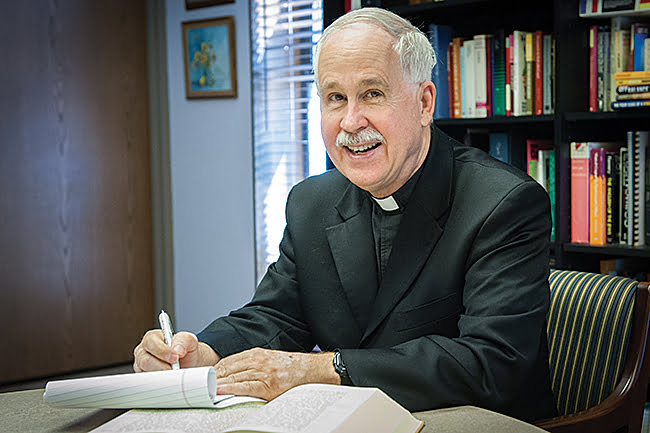
Father Mike Stubbs is the pastor of Holy Cross Parish in Overland Park and has a degree in Scripture from Harvard University.
When disaster strikes, people have to find someone to blame.
In the year A.D. 64, a fire broke out that ravaged much of the city of Rome. Rumors spread that the Emperor Nero had deliberately set the fire in order to clear out land on which to build a mansion. (In fact, Nero did build a mansion on the Palatine hill, which gives us the word “palace.”)
To avoid blame, Nero turned to the Christians to find a scapegoat. He accused the Christians of arson and had many of them condemned to death.
The Roman historian Tacitus described the scene: “Covered with the skins of beasts, they were torn by dogs and perished, or were nailed to crosses, or were doomed to the flames and burnt, to serve as a nightly illumination when daylight had expired” (Annals, XV, 44).
According to tradition, St. Peter died during this persecution by being crucified upside down. Sunday’s Gospel reading, Jn 21:1-19, indirectly confirms this account of Peter’s death.
At the end of a dialogue between Jesus and Peter, Jesus tells him: “When you grow old, you will stretch out your hands, and someone else will dress you and lead you where you do not want to go.” By these words, Jesus is predicting how Peter will die: “He said this signifying by what kind of death he would glorify God.”
A person condemned to death by crucifixion had to carry the crossbeam on his shoulders to the place of execution. That is why Peter has to stretch out his hands, so that his arms can be fastened to the crossbeam.
Next, the robes of the condemned person have to be hitched up, so that the person does not trip while walking. That is why the prediction says: “Someone else will dress you and lead you where you do not want to go.”
The prediction of Peter’s death comes at the end of Jesus’ conversation with Peter, during which Jesus has instructed Peter to tend Jesus’ sheep and feed them. Those are the duties of a shepherd. Jesus, the good shepherd, is calling upon Peter to assume the role of a shepherd, a pastor, for the flock that is the church.
The prediction of Peter’s death naturally follows that instruction. It echoes an earlier utterance in John’s Gospel: “The good shepherd lays down his life for the sheep” (10:11).
Like Jesus, Peter will also lay down his life for the sheep, in a manner very similar to that of Jesus.

